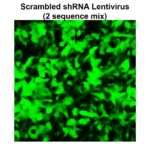-
Previous

h/m RDX shRNA Lentivirus
$595.00 – $1,195.00
- Next
TEAD Reporter Lentivirus
$595.00
Fluorescent TEAD Reporter Lentivirus (Hippo Pathway): High-quality, fluorescent lentiviral transcription factor (TF) reporter system that provides sensitive fluorescent readout for human/mouse TEA domain transcription factor (TEAD) activity in transduced cells. The transcription factor reporter lentivirus is purified by PEG precipitation and sucrose gradient centrifugation, and is ideal for studying TEAD/YAP or Hippo pathway activity in difficult-to-transfect cells including primary and/or thawed cells.
Have questions about this product? Need a stable cell line? Send us a form and we’ll reply the same day: Contact Us
Ultra-high concentration virus can be provided upon request in your choice of medium and volume for in vivo injection. We can provide custom reporter genes (such as SEAP, YFP, secreted Gaussia Luc, Renilla Luc, etc.) and selection markers (hygromycin, bleomycin, etc.) upon request.
Available Options:
- Specifications
- Selecting Proper Controls
- Lentiviral Transduction Protocol
- MSDS
- Additional Information
Specifications
Key Advantages:
- High Sensitivity – LipExoGen TF Reporter lentiviral particles are made using a novel vector platform based on the third generation system. The transcription factor’s response elements are arranged as DNA tandem repeats upstream of the minimal TATA promoter-driven reporter, and downstream of an optimized minimal enhancer (pc) of the human CMV promoter. When the signal pathway/TF is activated, the mini enhancer synergizes with TF binding to the response elements (up to 8 repeats in some products, depending on strength of reporter activation) to amplify expression of the fluorescent (GFP/RFP) or luciferase (Luc) reporter, with minimal enhancement of background. As a result, the reporter system provides a highly sensitive readout for signaling pathway or specific transcription factor activation in human and mouse cells.
- Easily Establish Stable Reporter Cell Lines – The reporter lentiviral particles are ultra-purified and concentrated to high-titer by PEG purification and sucrose gradient centrifugation to allow for efficient transduction of difficult-to-transfect cells, including primary and/or freeze-thawed cells. Stable cell lines are easily generated through puromycin or blasticidin selection.
- Discovery Made Easy – Signal pathway or specific transcription factor activity can be detected by fluorescence, making LipExoGen TF Reporter lentiviral particles more practical than traditional luciferase reporters and/or biochemical assays. Pathway/TF activation can be readout directly by fluorescence microscopy in living cell cultures, thus paving the way for unexpected discoveries.
- Readout On Flow – Fluorescent reporter activation can also be readout by flow cytometry, providing more versatility in data acquisition for labs with different instruments. anavar 50mg price 22 Inspiring Health-Wellness-Fitness Quo
- Best Value – LipExoGen lentiviral particle products are made using optimized lentiviral vectors developed in-house, which allows us to provide the highest quality products while retaining competitive prices. These high-titer lentiviral particles feature a highly sensitive fluorescent reporter system and have been validated to read out the indicated transcription factor activity.
- Completely Customizable – You can easily request a modified version of this product, such as a dual-reporter or a different reporter not listed here, by contacting us.
Details:
| LTV-0016 | |
| Hippo pathway | |
| TEAD response element | |
| Monitor Hippo activity. The fluorescent reporter enables convenient readout using flow cytometry, fluorescence microscopy, etc. | |
| Human/mouse |
Product Data:
Figure 1 (thumbnail). HEK293FT cells were co-transfected with TEAD-TAG-Puro plus either control plasmid (pcDNA Vector, left) or expression plasmid for human YAP1 (YAP1, right). Fluorescence microscopy images were taken 24-36 hrs later to assess GFP reporter expression in the live cells.

Figure 2. GFP reporter activation in cells co-transfected with TEAD-TAG-Puro and YAP1-P2A-RFP. HEK293FT cells were co-transfected with TEAD-TAG-Puro plus human YAP1-P2A-RFP (bottom) or pcDNA vector (top). After 24-36 hours, GFP reporter activity of TEAD-TAG-Puro was observed in the living cells with overexpression of human YAP1 (RFP).


Figure 3. GFP or RFP reporter co-expression with Firefly Luc HEK293FT cells were co-transfected with plasmid constructs for a TEAD dual reporter plus either vector or YAP1-HA for 36 h. Fluorescence microscopy images were acquired in the live cells to observe fluorescent reporter expression (top panels). The figure on the left shows the data for cells transfected with the construct for TEAD-GFP-Luc-Puro (LTV-0016-9S), while the figure on the right shows the data for TEAD-RFP-Luc-Puro (LTV-0016-12S). To visualize Firefly luciferase expression, the cells were then fixed with methanol and stained with anti-Luc-Alexa-594 or -488 antibodies, followed by fluorescence microscopy. The fluorescent (GFP or RFP) reporter is separated from downstream Luciferase reporter by P2A, but driven by the same YAP1-activated TEAD DNA-binding elements. The co-expression of fluorescent and luminescent reporters shows that the reporter can readout fluorescence and luciferase simultaneously in response to Hippo pathway activation.
Have questions about this product? Send us a form and we’ll reply the same day: Contact Us
Background
The Hippo signaling pathway is central to controlling organ size and tissue regeneration, and it is critically involved in regulating cell proliferation and apoptosis. TEAD1, a transcription factor activated by this pathway, plays a vital role in mediating these effects. Dysregulation of the Hippo pathway is linked to cancer, stem cell function, and tissue repair, underscoring its significance in health and disease.
LipExoGen’s TEAD1 Reporter Lentivirus provides a valuable tool for researchers studying this pathway. The product features a reporter system that emits a fluorescent or luminescent signal when TEAD1 is activated, facilitating the observation of pathway activity in real-time. This reporter is crucial for exploring Hippo pathway mechanisms and the development of potential therapeutic strategies targeting these signaling dynamics.
Vector Diagram
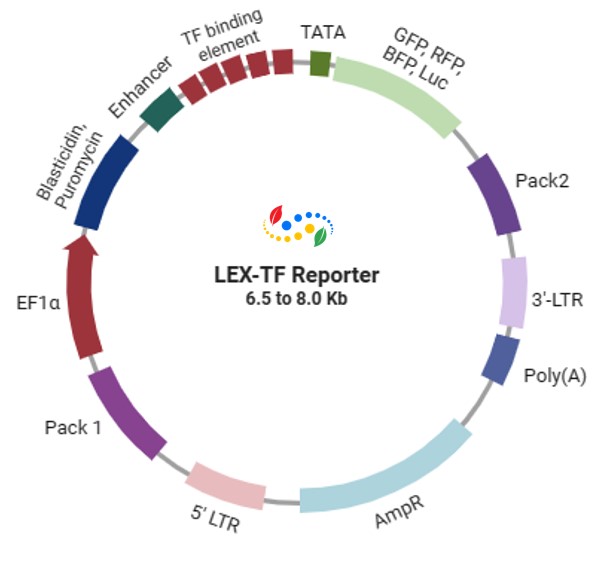
Recommended Controls
Reporter Negative Control Lentivirus – Ready-to-transduce lentiviral particles expressing minimal TATA box-driven reporter. The construct is the same as the TF Reporters except that it lacks the transcriptional response elements which drive signal pathway/TF-specific reporter expression. The reporter negative control lentiviral particles allow to establish a baseline for background reporter activity and determine specificity of any treatments to activate the reporter.
Reporter Positive Control Lentivirus – Ready-to-transduce lentiviral particles with constitutive expression of the reporter. The reporter positive control lentivirus is useful for transduction optimization studies, especially if the cells are very sensitive or difficult-to-transduce.
Renilla Luciferase Internal Control Lentivirus – Ready-to-transduce lentiviral particles expressing minimal TATA box-driven Renilla luciferase (RLuc).
Publications
Custom Orders
If you require a modification to one of our products, such as a change in reporter or other vector component, please contact us. Examples of customization options are shown in the table below. Feel free to request something not in the table.
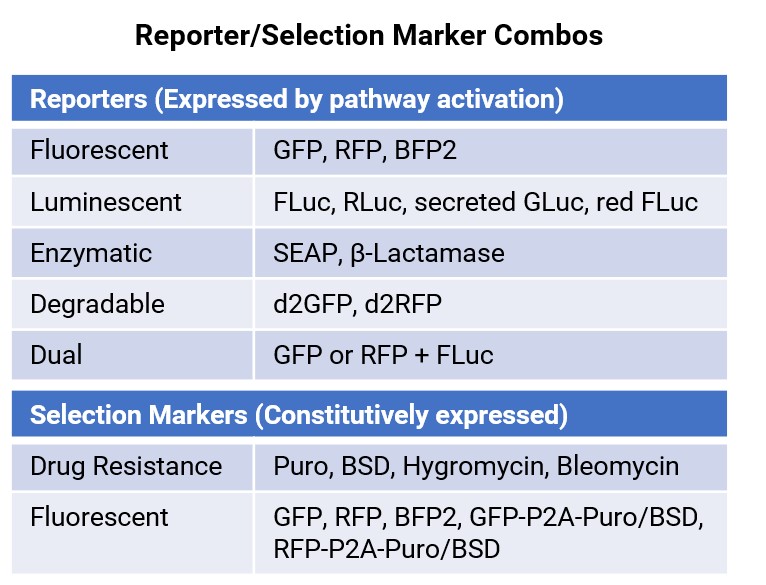
Additional Custom Service Options
- Send us your cells and we can establish a stable TEAD reporter cell line for you using this product. Learn more.
- ORF cDNA plasmids featured in the product figures are available upon request.
- Ultra-high concentration TEAD reporter virus can be provided upon request in your choice of medium and volume (i.e. for in vivo applications).
Selecting Proper Controls
Selecting Proper Controls
ntroduction
It is important to know if and when to use the proper controls for this product. The reporter lentivirus behavior will depend on the situation and therefore vary based on the conditions and cells it is being used in. We sell positive and negative control lentiviral particles which can be helpful in optimizing the conditions necessary to activate or inhibit the reporter activity, normalize luminescent signal (i.e. Renilla internal control), and troubleshoot the needed transduction conditions. Not everyone will need to use these controls, particularly if they are experienced with handling lentiviral reporters or perhaps if they have already purchased our product and determined ideal conditions for it already. However, we recommend using the proper controls always to ensure that the user can properly assess what they are seeing in their cells after transducing with our lentivirus. It should be noted that in some cases, an agonist (for example, TNF-alpha or LPS) may be needed to activate the reporter, and not all commercially-available agonists will work. We have had instances where TNF-alpha from one company cannot activate one of our reporters, whereas seemingly the same product from another company can. In these instances, we will do our best to inform of this on the website, however it is ultimately the responsibility of the buyer to figure these things out. If you observe something like this, we encourage you to contact us so that we can make the information available to others on our website.
The bottom line: When in doubt, use controls!
There are several different kinds of controls that you should consider when purchasing a reporter lentivirus from us. You have to decide which ones you will need, since it may depend on your particular application. Below is a general description which should help you in determining your individual needs. If you have questions, you can just contact us.
I. The Actual TF Reporter

Cat. No.: Various
Purpose: Experimental. This is the actual reporter that you will use to test the transcriptional activity of the indicated response elements in your experimental conditions. Example: test if a condition results in activation or inhibition of NFκB transcriptional activity.
Explanation of components:
Selection: Refers to the drug selection marker gene that is used to allow you to select the transduced cells and make a stable cell line. Currently you get 2 options, either puro or BSD.
Enhancer: This refers to an optimized minimal enhancer from the human CMV promoter. It is present in all of our TF Reporter constructs and functions by amplifying the reporter transcription driven by specific TF binding to response elements and the minimal TATA promoter.
TF Binding: Refers to the specific transcriptional response elements that are present to allow pathway or TF specific activation of the reporter. They are generally arranged as tandem repeats and the number of repeats varies depending on the product.
TATA: Minimal TATA promoter. Alone, it is insufficient to drive strong transcription of the reporter. It works together with the TF-bound response elements to drive the reporter expression when the specific signal pathway or TF is transcriptionally active.
Reporter: The fluorescent or luminescent reporter that is used to readout the pathway or TF activity in the transduced cells. Currently you can choose GFP, RFP, or Firefly Luciferase (FLuc).
II. Controls

Purpose: Establish a frame of reference for “positive reporter signal” that is independent of the pathway or TF-specific transcriptional response elements. The construct is organized the same as the actual TF reporters, except that a synthetic “constitutively active” TRE sequence is used to drive reporter activation in the cells. The reporter signal in the resultant cells can be used as a positive control to gauge whether the transduction conditions need to be optimized or if your particular test conditions are insufficient to activate the actual TF reporter.
Example 1: You are trying a specific ligand to induce the activity of your TF reporter, and not seeing much reporter activation. The positive control can help you determine if this is an issue with your transduction or if the ligand you selected is unable to activate the reporter. You may need to troubleshoot the ligand, add another ligand, co-transfect the cells with another gene, or something else.
Example 2: You are testing the inhibitory effect of your compound on a specific signaling pathway and see that it produces good inhibition. You can use the reporter positive control cells to confirm the effect of the compound is specific to that signaling pathway, not an off-target effect such as broad inhibition of transcription or translation.
How to use: Transduce a separate batch of cells (not the same ones that will receive the actual TF reporter). The reporter positive control should have the same selection marker and reporter as the actual TF reporter you are using to assay the desired transcriptional activity. This ensures you can control for any impact of the drug selection. Treat the transduced cells the same way as the ones that were transduced with the TF reporter. Use the reporter signal you observe to get an idea what reporter activation should look like in your cells.
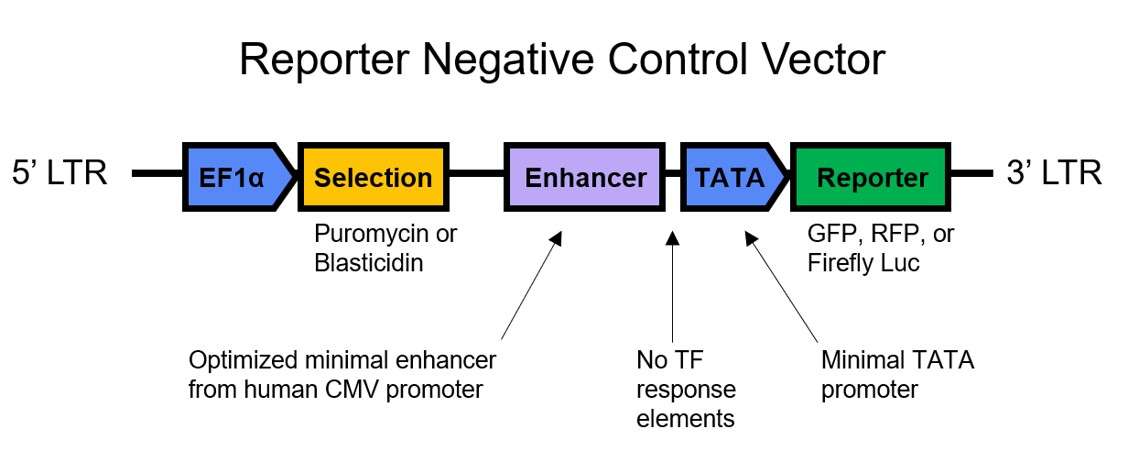
Purpose: Establish a baseline for any background reporter activity.
How to use: Transduce a separate batch of cells (not the same ones that will receive the actual TF reporter). The reporter negative control should have the same selection marker and reporter as the actual TF reporter you are using to assay the desired transcriptional activity. This ensures you can control for any impact of the drug selection. Treat the transduced cells the same way as the ones that were transduced with the TF reporter. Any reporter activation or inhibition you observe represents the basal level (independent of transcriptional response elements).

RLuc Internal Control (Constitutive)
Purpose: Establish a frame of reference for “positive reporter signal” that is independent of the pathway or TF-specific transcriptional response elements. The advantage of the RLuc internal control is that it can be used in the same cells that receive the actual TF reporter construct driving Firefly luciferase. Thus, it can be in dual luciferase assays. The construct is organized the same as the actual TF reporters, except that a synthetic “constitutively active” TRE sequence is used to drive reporter activation in the cells. The reporter signal in the resultant cells can be used as a positive control to identify well-to-well variations since the Renilla luciferase can be detected separately from Firefly luciferase in the same batch of cells.
Example 1: You are trying a specific ligand to induce the activity of your TF reporter, and not seeing much Firefly luciferase reporter activation. If Renilla luc is also not being detected, it could indicate an issue with your cells, transduction/selection conditions, the instrument, or specific reagents being used. If you can detect RLuc but not FLuc, then it likely means the effect is pathway or TF-specific based on the TF reporter you are using. Note: to rule out reagent- or equipment-specific issues related to FLuc but not RLuc, you would need to transduce a separate batch of cells with Reporter Positive Control (LTV-0072) with FLuc as the reporter. The positive control can help you determine if this is an issue with your transduction or if the ligand you selected is unable to activate the reporter. You may need to troubleshoot the ligand, add another ligand, co-transfect the cells with another gene, or something else.
Example 2: You are testing the inhibitory effect of your compound on a specific signaling pathway and see that it produces good inhibition. You can use the constitutive RLuc internal control to verify that the effect of the compound is specific to that signaling pathway, not an off-target effect such as broad inhibition of transcription or translation.
How to use: Transduce the same batch of cells that will receive or already received the actual TF reporter. The RLuc Internal Control (Constitutive) should NOT have the same selection marker as the actual TF reporter you are using to assay the desired transcriptional activity. For example, if the actual TF reporter is using puro for selection, then the RLuc internal control should use blasticidin (BSD) and vice versa. This ensures you can select the same cells twice, once for the actual TF reporter, and again for the internal control. We strongly recommend that this be performed in two separate transductions. You should transduce the cells with one of the lentiviruses first, select the transduced cells, and let them grow up and completely recover before proceeding to the next round of transduction and selection with the second lentivirus. Details can be found in our transduction protocol which comes with each product and is also available under a different tab on this page.
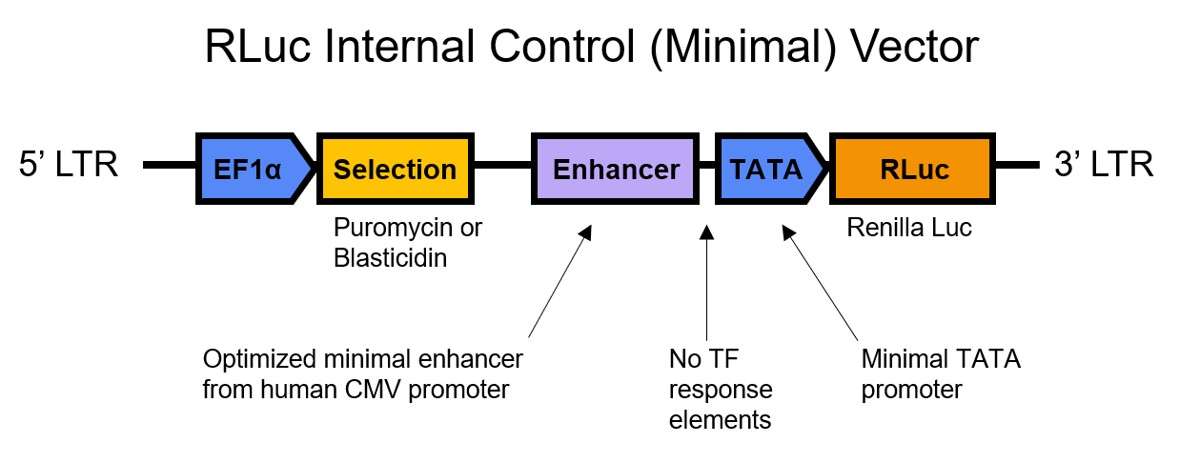
RLuc Internal Control (Minimal)
Purpose: Establish a baseline for any background reporter activity in the same cells that contain the actual TF reporter construct. The advantage of the RLuc Internal Control is that it can be used in the same cells that receive the actual TF reporter construct driving Firefly luciferase. Thus, it can be used in dual luciferase assays. The construct is organized the same as the actual TF reporters, except that there are no transcriptional response elements to drive the expression of RLuc. Thus, any RLuc signal that is produced under your experimental conditions represents the basal activity of the construct independent of the transcriptional response elements (minimal TATA and upstream enhancer). This is useful in experiments where you are trying to study the reporter activation and need know the background level in dual-luciferase assays.
How to use: Transduce the same batch of cells that will receive or already received the actual TF reporter. The RLuc Internal Control (Minimal) should NOT have the same selection marker as the actual TF reporter you are using to assay the desired transcriptional activity. For example, if the actual TF reporter is using puro for selection, then the RLuc internal control should use blasticidin (BSD), and vice versa. This ensures you can select the same cells twice, once for the actual TF reporter, and again for the internal control. We strongly recommend that this be performed in two separate transductions. You should transduce the cells with one of the lentiviruses first, select the transduced cells, and let them grow up and completely recover before proceeding to the next round of transduction and selection with the second lentivirus. Details can be found in our transduction protocol which comes with each product and is also available under a different tab on this page.
Lentiviral Transduction Protocol
Lentiviral Transduction Protocol
MSDS
Additional Information
Additional Information
| TEAD1 | |
| TEA domain transcription factor 1 | |
| n | NM-021961.6 |
| Homo sapiens/mus musculus | |
| Alias | Member 1 (SV40 Transcriptional Enhancer Factor); Transcriptional Enhancer Factor TEF-1; Transcriptional Enhancer Factor 1; Transcription Factor 13; Protein GT-IIC; NTEF-1; TCF-13; TEAD-1; TCF13; Atrophia Areata, Peripapillary Chorioretinal Degeneration; TEA Domain Family Member 1; TEF-1; REF1; TEF1; AA |
| Annotation Page | https://www.ncbi.nlm.nih.gov/gene/?term=NM-021961.6 |
| Gene IDs | HGNC:HGNC:11714 Ensembl:ENSG00000187079 MIM:189967 |
| Entrez Gene Summary | “This gene encodes a ubiquitous transcriptional enhancer factor that is a member of the TEA/ATTS domain family. This protein directs the transactivation of a wide variety of genes and, in placental cells, also acts as a transcriptional repressor. Mutations in this gene cause Sveinsson’s chorioretinal atrophy. Additional transcript variants have been described but their full-length natures have not been experimentally verified. [provided by RefSeq, May 2010]” |

